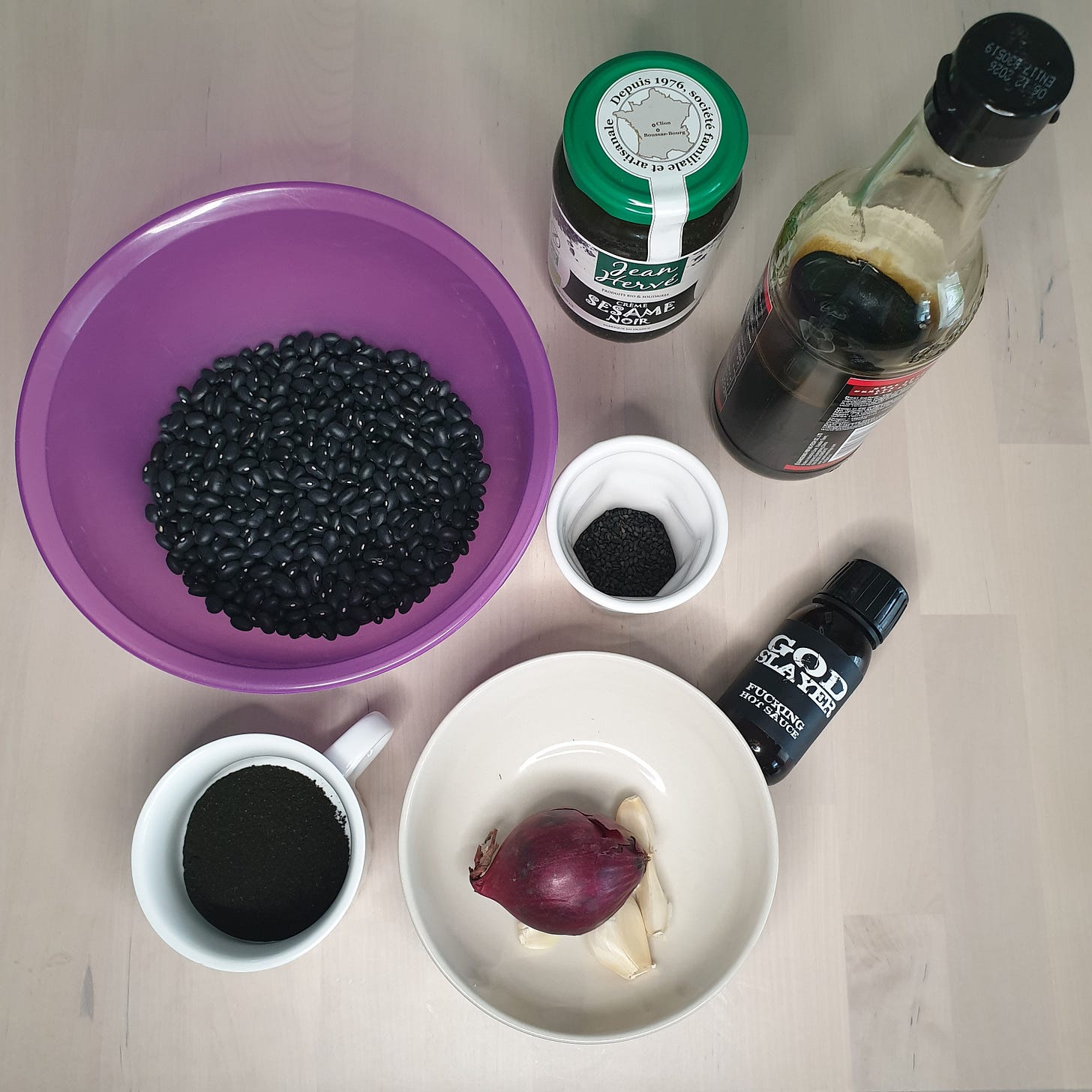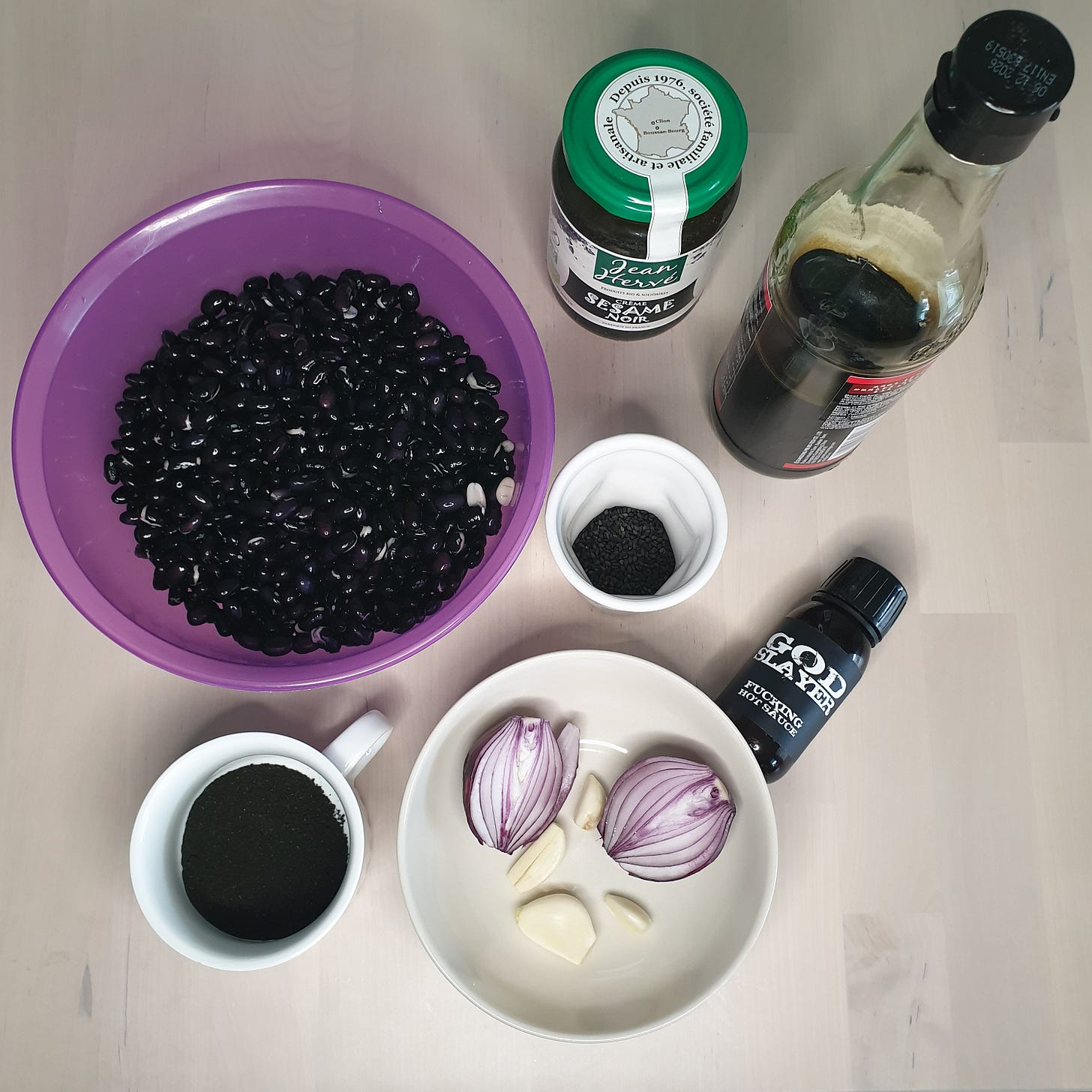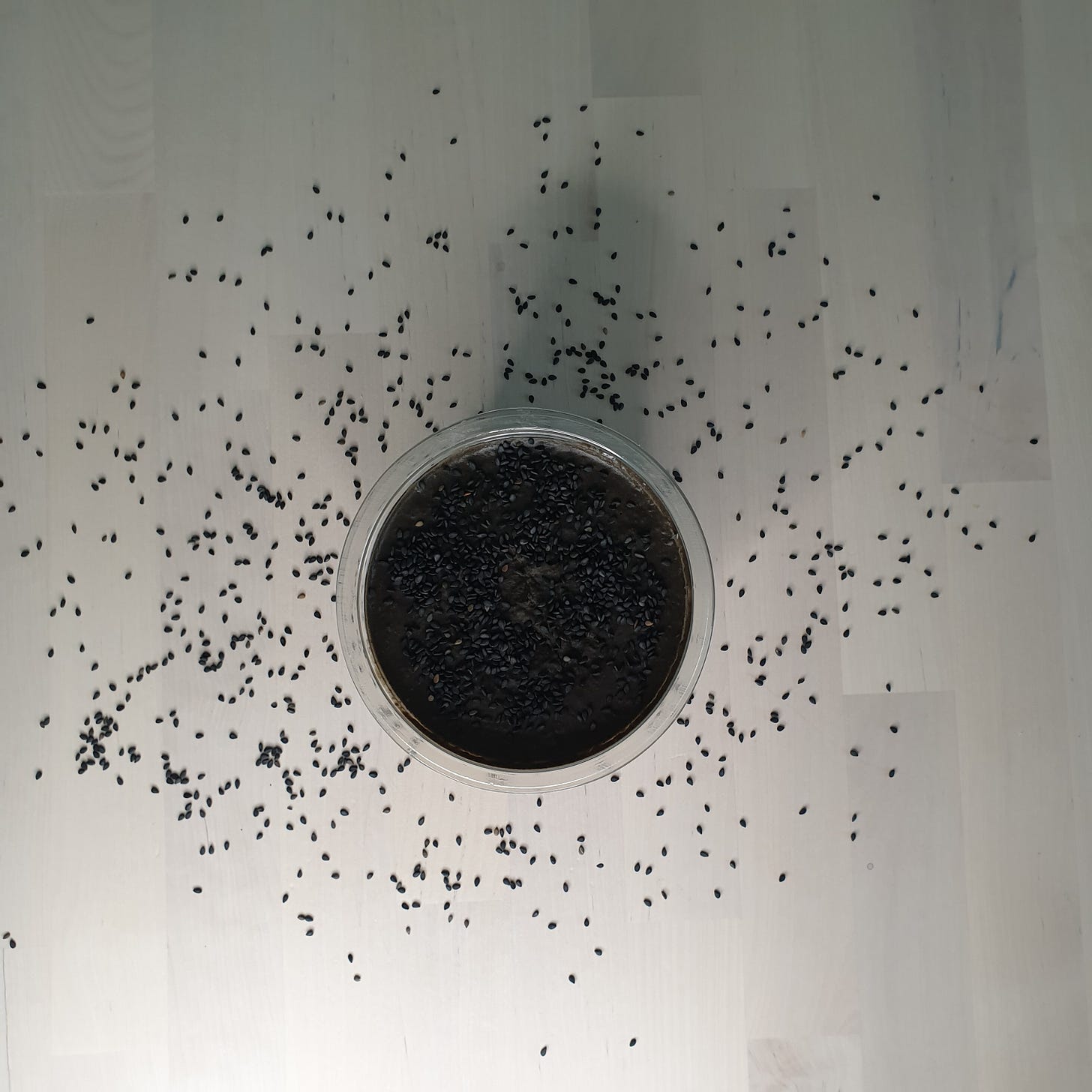Black lava hummus-style spread
This turns black beans into an hummus-style spread which can have no other name than "black lava". The more your add of the optional ingredient, the closer it is to actual lava.
Serves: many — though how many will survive?
Preparation: 5 minutes + overnight soaking
Cooking: 75 minutes

If you are a year-long subscriber of Guillaume Cooks Vegan, you know I love hummus, and everything which is prepared in a similar fashion. I don’t know if it’s something all vegans fancy, however I do — and I did before I turned to veganism. As I’m quietly walking away from industrial vegan alternatives to cheese, I enjoy more and more hummus or any home-made preparation I can spread on bread with burgers, or dilute with hot water to make pasta sauce. You may also have read that a close friend of mine organizes a barbecue every year during the month of May, to launch the season of barbecues (although I believe I’m the only one to say so), and I bring an hummus, or something similar, every year. Two years ago, I had swapped tahini for peanuts, and it had a Cajun touch. Last year, I had swapped the chickpeas for edamame beans, and it had a Japanese touch. This year, I was looking for an hummus, or an hummus-like preparation, which would differ from my previous “achievements”.
The friend inviting us to the barbecue had offered me black sesame paste. And I recalled I had some black curry powder and black sesame seeds on the shelf, a very dark soy sauce and dried black beans elsewhere in the kitchen. It sounded like I was set to bring something whose dominant color was black! I had black garlic, however I wasn’t sure the flavor would team up with others, so I left it aside. I was wondering which chili pepper I could add to power up the spread. And I thought it would be epic if I used an extreme hot sauce, which contains capsaicin oleoresin, to turn the spread into lava. For your own safety, please consider this as a totally optional ingredient — the author declines all responsibility for injuries related to preparing, tasting, or evern reading this recipe.
About capsaicin oleoresin

The optional ingredient of this recipe is a hot sauce containing “capsaicin oleoresin”. Capsaicin is the molecule responsible for the pungency (the heat) of the chili peppers, and whose concentration gives their strength. An oleoresin is a semi-solid resin obtained by evaporation of non-aqueous solvents. You can see an oleoresin in the middle of a large spectrum, with essential oils on one end and gummies on the other end. Oleoresin is a concentrate of essentials, resins and fatty oils, however it’s not fully solid.
As a reminder, the pungency of chili peppers is measured against the Scoville scale, in Scoville Heat Unit (SHU). Jalapeño ranges between 2,500–10,000 while the stronger Tabasco pepper varies between 25,000–50,000. The official strongest chili pepper to date, Pepper X, tops 2,693,000 SHU and pure capsaicin is 16,000,000 SHU.
The hot sauce I used contains the following ingredients: tomato, cider vinegar, garlic, bourbon, lime juice, Carolina Reaper chili pepper (1,500,000–2,500,000 SHU), Habanero chili pepper (100,000–350,000 SHU), 9,000,000 SHU oleoresin, salt, herbs. You get what I mean by “lava”, now: beside the capsaicin oleresin, it packs extracts from two strong chili peppers — and garlic.
Ingredients

250 g dried black beans or 500 g canned black beans
1 table spoon black sesame paste/tahini1
3 soup spoons of black curry powder (as an alternative, use any spice mix you fancy)
1 red onion ~ 50 g
Garlic cloves ~ 10 g
3 soup spoons of dark soy sauce2
1.5 L water
Black sesame seeds to decorate3
A very hot sauce, powered by capsaicine oleoresin ~ as much as you want it to be lava
Preparation
As with hummus, there’s very little to prepare, and it’s pretty straightforward. Still, the Preparation steps take long, due to the soaking of the dry black beans. You can’t speed up the process, however you can settle for pre-cooked black beans — see tip at the bottom of the page.
Soak dry black beans in a large volume of water; it has to be large enough so they won’t surface when they grow during the process (go for 3x to 5x the volume of black beans)
Peel garlic cloves
Peel the red onion, cut in half

Cooking
I usually cook beans and pulses in a stainless steel pot, which I cover with a plate. I avoid non-stick cookware when I cook with water. For the mixing steps, I use a blender, however a food processor is more indicated, should you have one.
Heat the soaked black beans with 1.5 L fresh water (don’t use the soaking water) on maximum flame/power
When the black beans are boiling, lower to 30% flame/power, cover, and cook for 1 hour
Using a skimmer, transfer the cooked black beans to a blender
Add all other ingredients but the black sesame seeds, and blend
Add cooking water to the blender until it reaches the desired texture
Sprinkle black sesame seeds for decoration

I recommend using a skimmer rather than a ladle, because the latter may bring in too much water in the blender. Should the mix be too liquid, you may no longer be able to spread it on bread; you would end up with a liquid sauce for dipping (which is another option).

Try to blend as much as possible without cooking water. Add some only once it’s no longer possible to proceed otherwise; if you have a blender like I do, this may come earlier than if you use a food processor.
Like a traditional hummus, this is better enjoyed cold than warm. Let it cool to room temperature, then refrigerate. You may have hesitated adding the optional hot sauce containing the capsaicin oleoresin, so here’s my solution: secure a “lava-free” part before adding the chili to the blender. Sprinkle black sesame seeds on one and not on the other so you can differentiate them afterward.

Unlike a traditional hummus, this doesn’t taste like hummus. The hummus-alikeliness is limited to the type of ingredients the recipe packs. It’s expected that it doesn’t taste like hummus, since black beans have a very different flavor than chickpeas. Even the black sesame paste tastes so different from traditional tahini. So, in the end, it looks like a black hummus, though it’s not a hummus — not even remotely.

Enjoy!
If you’ve tried the recipe, and would like to comment (whether you loved it, or hated it), please do so! I’m welcoming ideas, even if these are non-vegan recipes I’ll have the challenge to “veganize”.
Here’s a tip before you go
You can use 500 g canned black beans instead of 250 g dried ones. In such case, adapt the preparation and cooking steps as following: skip the soaking step (obviously!), cook the black beans with the liquid from the can instead of 1.5 L water, and cook for 10 minutes instead of 1 hour.
Be cautious: tahini is make of sesame, which is a know allergen
Be cautious: soy sauce is made of soy (hence the name) and it sometimes includes wheat; both are known allergens
Be cautious: sesame is a known allergen



